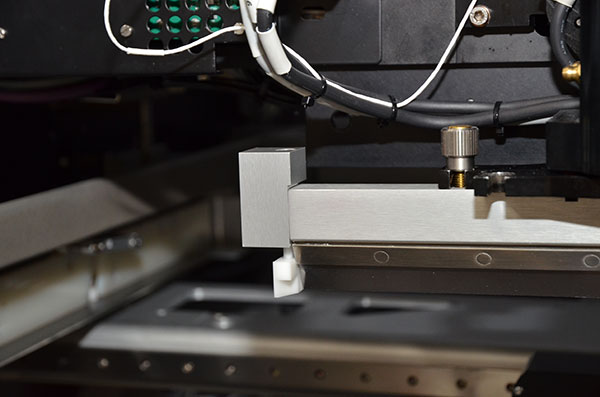Deflecting Material Waste and Stencil Damage
 Self-adjusting paste deflectors save solder paste and simplify cleaning.
Self-adjusting paste deflectors save solder paste and simplify cleaning.
Regular readers of my column are certainly well aware of the challenges around print process variability and the impact even small changes can have on printing results. With a procedure as dynamic as printing, ensuring every input is spot-on is critical to a good outcome, especially in the age of miniaturization. This holds true for what many would consider even the most minor of details: the paste deflector.
Every squeegee our company supplies to a manufacturer comes with a set of paste deflectors. These very simple pieces of formed metal are mechanically connected to the squeegee body with two bolts, and their job is to keep the solder paste material from moving outside the print area. They act like dams to keep material within the angle of the squeegee. While paste deflectors play an important role in reducing material waste and maintaining material integrity, they don’t come without challenges. Setting the height of the paste deflectors is a manual operation, and getting them just right can be tricky. If the deflector is set a bit too low, when the squeegee comes down to meet the stencil and pressure is applied, the deflectors will actually grind into the stencil. At worst, the deflector can punch a hole through the stencil, but it will most certainly leave a trail or coin the stencil if set even slightly too low (FIGURE 1). To avoid damage, operators often set the deflectors a little higher to permit a margin of error. This approach, however, lets paste run underneath the gap, and enables material to run up the outside of the squeegee, which can also introduce process problems.

Figure 1. Manually set, conventional paste deflectors can damage stencils.
Because of these issues, many manufacturers have simply opted not to use deflectors. This solution isn’t optimal either. When solder paste is deposited in front of the squeegee blade and the pressurized squeegee traverses over the stencil, the paste has a tendency to roll to the side due to centrifugal forces. Without deflectors, all that high-quality paste is leaking out to the side of the squeegee instead of staying in front of it. To prevent wasting material, the operator usually scoops up the paste that’s been pushed to the side and puts it back in the roll. The material could have been outside of the paste roll for 10 minutes or 10 hours; either way, it hasn’t been homogenized, worked or consumed. When put back into the roll, it’s now a very different material. The material that has remained in front of the squeegee blade has been running just fine at an optimal viscosity, and now that dynamic has changed with the introduction of material that has been static. Getting back to an ideal viscosity will likely take at least a couple prints, meaning at least two – if not more – boards may be subjected to print defects.
To address the challenges with manually set deflectors and the frustrations that lead to using deflector-free squeegees, a new self-adjusting paste deflector technology has been developed. Instead of being connected with tedious bolts, the self-adjusting deflectors are housed in metal blocks that simply fit over the ends of the squeegee to simplify attachment (FIGURE 2). When the squeegee comes down and pressurizes, the deflectors self-level, so they are always coplanar with the stencil at just enough pressure to prevent the solder paste from moving underneath and creating a tram line. The operator no longer has to set up the deflector tool manually. In addition, cleaning the deflector becomes simpler than with previous, bolted-on deflectors. When paste gets trapped in the edges of traditional deflectors, disassembling them to clean the dried paste can be challenging. With the self-adjusting paste deflectors, the entire mechanism can be put into an ultrasonic bath and thoroughly cleaned.


Figure 2. New self-adjusting paste deflectors are easy to attach and eliminate the frustrations associated with conventional deflectors, while delivering the benefits of paste containment.
No matter the operation – small, medium or high volume and from mobile phones to high-value server boards – taking variation out of the process is essential to achieving zero defects. The self-adjusting paste deflector is one of many ways to lower variability, decrease costs by eliminating stencil damage and reducing material waste, and save valuable production time. It’s a simple solution to an often overlooked component of the print process.
is global applied process engineering manager at ASM Assembly Systems, Printing Solutions Division (asmpt.com); clive.ashmore@asmpt.com. His column appears bimonthly.
Press Releases
- Altus Reports Growing Demand for Guidance on Convection Reflow Oven Specification
- Coherix Opens New Adhesive-Dispensing Vision Center in Europe
- Pan Pacific Strategic Electronics Symposium Program Finalized
- The Most Critical 2 Inches in SMT Manufacturing – When a Splice Fails, the Line Fails, Full Stop. Throughput and Yield Depend on One Overlooked Moment







